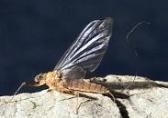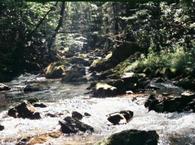
Mayflies are perhaps the most imitated insects within a trout fisherman’s fly box. Both the adult and nymph stages are an important food source in most any trout river across the country. Yet one of the most common mistakes I see my clients make is misidentifying the most common mayflies, or simply misunderstanding the lifecycles. Lets break this down simply, as this hopefully helps our overall recognition and understanding of these essential bugs.
Mayflies hatch from eggs attached to stones or other objects in the water. Once hatched the mayfly nymph’s diet consist of small aquatic organisms and other organic debris. Mayfly nymphs will go through a series of growth changes, called instars. The last nymphal instar molts or sheds to the winged form at the water surface or on an object just out of the water. Many emerger patterns are tied to mimic the mayflies in this vulnerable stage, called the subimagos. The entire nympal process can last a couple of months to an entire year, depending on the species. The mayflies will molt once more before becoming a true adult. The adults seldom live for more than a day or two. They do not feed, as there sole purpose is to reproduce, and lay eggs. Eggs are attached to the river bottom by diving females or simply washed off the abdomen when they land on the water’s surface. After the males reproduce and the females lay their eggs, they will die usually falling to the water in what fly-fisherman call a spinner fall.
Mayflies can be broken down into three scientific families, burrowing mayflies, stream mayflies, and small mayflies. Their scientific family names are Empheridae, Heptageniidae, and Baetidae respectively. Each family is separated by distinct characteristics such as size, habitat, wing venation, and body segmentation.
Family Emperidae, or burrowing mayflies occur in ponds, lakes, and large rivers. Naturally they are burrowing in habit as nymphs. These are our largest mayflies of the three families. Most have clear wings, while a few have spotted wings. Burrowing mayflies can generally be found in huge swarms in the great lakes or in many of our large Tennessee River lakes, such as Norris, Watts Barr, etc. A common example for fly fisherman would be the Hexagenia mayfly, or Hex fly patterns in sizes 8-12. Hatches usually take place in mid spring through early summer.
Family Heptageniidae, or stream mayflies are found in most flowing streams across the country. The nymphs are flattened and streamlined, and live on the underside of stones in streams. Adults are medium-sized to small compared to burrowing mayflies and usually clear winged. These are the most commonly fished mayflies due to their prevalence in many of our countries top rivers. The bugs commonly called Sulfurs and Pale Morning Duns are examples of stream mayflies. Nymph patterns of the Sulfurs and PMDs in size 14-20 will do a good job of imitating these mayfly nymphs.
Dry flies of the same size, will imitate the adults. Heptageniidae hatches usually start in mid spring and continue through late summer.
Family Baetidae, or small mayflies, are also found in various aquatic habitats across the country. They are especially common in tailwaters such as the Watauga and South Holston in East TN, where I do most of my guiding. The nymphs and adults are smaller than their other mayfly cousins, usually measuring less than 15mm in length. The nymphs are more cylindrical than those of Family Heptageniidae. Like stream mayflies, they can be found on the undersides of rocks or within tangled stream vegetation and debris. The most commonly known small mayfly is the blue wing olive. Sizes 18-24 BWO nymph patterns will do a good job of imitating the nymphs. BWO dry flies in the same sizes are the most commonly used dry flies to match the hatching adults. Small mayflies will hatch year-round often-preferring cloudy days.
So next time you are on the water and you see some mayflies flying about, first determine the size and color of the bug. Next determine what phase of the lifecycle the trout are keying in on. Are they sipping spinners falling down to the waters surface, or are flashing two feet underwater eating emergers as they make their ascent up the water column? From here you will choose between a nymph, an emerger, or a dry fly. Now match up the color and size of your fly to the bugs you see under the rocks or flying around. From here with some good casting and presentation techniques you should be able to match the hatch and catch some fish.
Summary:
- First determine the size and color of the insect.
- Determine the phase of the lifecycle.
- Select nymph, emerger or dry fly.
- Make good presentations.
Thanks to Justin Shoyer of The Trophy Water Guide Service for providing this insight into Mayflies.





